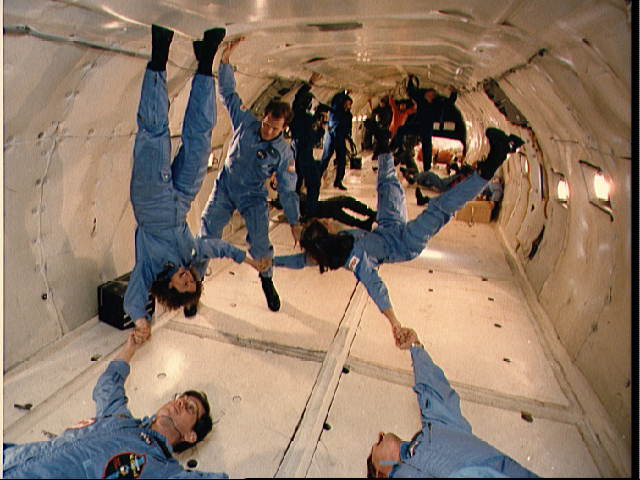ASTRONAUT TRAINING

Astronaut candidates experience "apparent
weightlessness" in a KC-135 aircraft. Photo courtesy of NASA.
The required training depends very much
on each astronaut's mission and role. For example, an astronaut
who will walk on the Moon needs different training than an astronaut
who will use the space shuttle's robotic arm to capture a satellite.
Astronaut pilots spend countless hours
training with flight simulators. They also fly T-38 jets to keep
their skills sharp.
Some of the Apollo astronauts who landed
on the Moon had geological training at the Grand Canyon and Meteor
crater. Both of these sites are in Arizona. In addition, some
of the astronauts studied volcanoes in Hawaii.
Neil Armstrong trained for his Moon landing
in a lunar landing research vehicle (LLRV). This vehicle was called
"the flying bedstead" because it was a wingless platform,
somewhat like an old brass bed frame. It was designed to fly up
to 500 feet above the Earth. It had a propulsion system with thrusters
and hand controls. The propulsion system was designed to balance
the Earth's gravity in a manner that simulated the Moon's gravity.
The Moon's gravity is one-sixth G, compared to the Earth's which
is 1 G. Anyway, the LLRV was a poorly designed vehicle which crashed.
Fortunately, it had an ejector seat. Neil Armstrong was able to
eject just in time. His parachute opened just before he landed
on the ground.
Michael Collins and other Apollo astronauts
had survival training in the jungles of Panama, in case their
command module landed in the jungle instead of the ocean. Collins
learned to eat palm tree hearts and iguana as part of this training
exercise.
One training exercise that all astronauts
receive is a ride on a KC-135 aircraft. This plane climbs upwards
in a steep trajectory. Its acceleration reaches 2 G. At the top
of its climb, the plane suddenly free-falls for 20 to 30 seconds.
The passengers experience "apparent weightlessness"
during this free-fall. They ride in a padded area where they can
practice working in space during the free-falls.
This plane is called the "Vomit Comet"
for obvious reasons. It typically makes a series of several climbs
and falls during each training flight.
The STS-82 space shuttle astronauts trained
for extravehicular activity (space walks) in a number of locations.
One training center was the 40-foot deep Neutral Buoyancy Simulator
at the Marshall Space Flight Center in Huntsville, Alabama. This
simulator is actually a deep swimming pool.
The STS-82 astronauts rehearsed their Hubble
Space Telescope servicing mission in this pool. They also practiced
using more than 150 specialized tools and items developed specifically
for this mission. These tools included battery-operated power
tools.
Here are some reference books:
1. Buzz Aldrin and Malcolm McConnell, Men
from Earth, Bantam, New York, 1989.
2. Michael Collins, Liftoff, Grove Press, New York, 1988.
3. Walter M. Schirra, Jr., Schirra's Space, Quinlan Press, Boston,
1988.
4. A. Shepard and D. Slayton, Moon Shot, Turner, Atlanta, 1994.
5. Arthur C. Clark, Man and Space, Time-Life Books, New York,
1968.
6. William R. Shelton, Man's Conquest of Space, National Geographic
Society, Washington, D.C., 1968.
7. M. Scott Carpenter, et al., We Seven, by the Astronauts Themselves,
Simon and Schuster, New York, 1962.
8. B. Bondar and R. Bondar, On the Shuttle Eight Days in Space,
Greey de Pencier Books, Toronto, 1993.